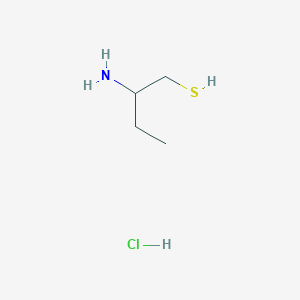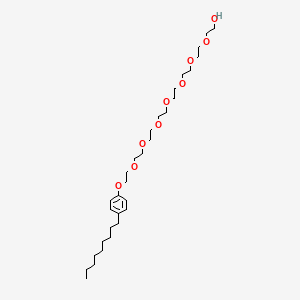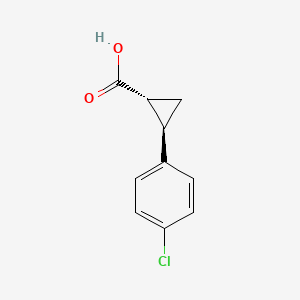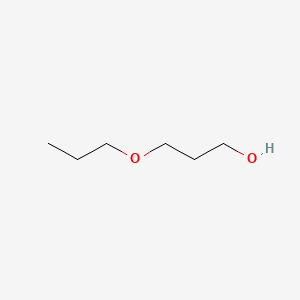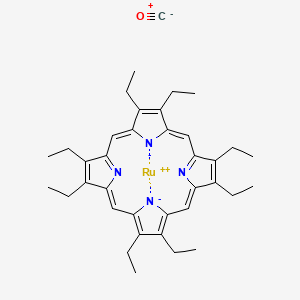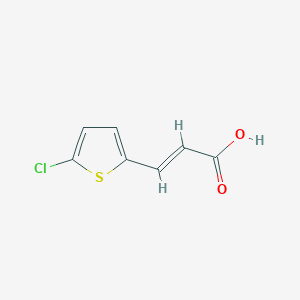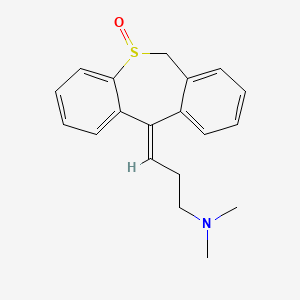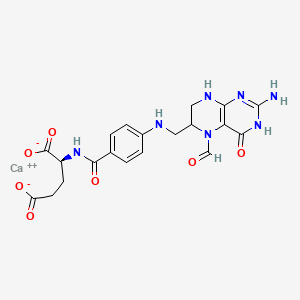
CID 135738681
- Cliquez sur DEMANDE RAPIDE pour recevoir un devis de notre équipe d'experts.
- Avec des produits de qualité à un prix COMPÉTITIF, vous pouvez vous concentrer davantage sur votre recherche.
Vue d'ensemble
Description
The compound with the identifier “CID 135738681” is a chemical entity listed in the PubChem database. It is characterized by its unique molecular structure and properties, which make it of interest in various scientific fields.
Méthodes De Préparation
Synthetic Routes and Reaction Conditions
The preparation of CID 135738681 involves specific synthetic routes. One such method includes reacting 2-fluoro-4-substituted phenylacetic acid with a Vilsmeier reagent, followed by quenching the reaction solution in an aqueous solution to obtain an intermediate . This intermediate is then further processed to yield the final compound.
Industrial Production Methods
Industrial production methods for this compound typically involve large-scale synthesis using optimized reaction conditions to ensure high yield and purity. The exact details of these methods are often proprietary and may vary between manufacturers.
Analyse Des Réactions Chimiques
Types of Reactions
CID 135738681 undergoes various chemical reactions, including:
Oxidation: This reaction involves the addition of oxygen or the removal of hydrogen.
Reduction: This reaction involves the addition of hydrogen or the removal of oxygen.
Substitution: This reaction involves the replacement of one atom or group of atoms with another.
Common Reagents and Conditions
Common reagents used in these reactions include oxidizing agents like potassium permanganate, reducing agents like lithium aluminum hydride, and various nucleophiles for substitution reactions. The conditions for these reactions typically involve controlled temperatures and pH levels to ensure the desired outcome.
Major Products
The major products formed from these reactions depend on the specific reagents and conditions used. For example, oxidation may yield carboxylic acids, while reduction may produce alcohols.
Applications De Recherche Scientifique
CID 135738681 has a wide range of applications in scientific research:
Chemistry: It is used as a reagent in various organic synthesis reactions.
Biology: It serves as a tool for studying biochemical pathways and molecular interactions.
Medicine: It is investigated for its potential therapeutic effects and as a lead compound in drug development.
Industry: It is utilized in the production of specialty chemicals and materials.
Mécanisme D'action
The mechanism of action of CID 135738681 involves its interaction with specific molecular targets and pathways. It may bind to enzymes or receptors, modulating their activity and leading to various biological effects. The exact molecular targets and pathways can vary depending on the context of its use.
Comparaison Avec Des Composés Similaires
Similar Compounds
Similar compounds to CID 135738681 include other fluorinated phenylacetic acid derivatives and related chemical entities. These compounds share structural similarities but may differ in their specific functional groups and properties.
Uniqueness
What sets this compound apart from similar compounds is its unique combination of functional groups and molecular structure, which confer specific reactivity and biological activity. This uniqueness makes it a valuable compound for targeted research and applications.
Conclusion
This compound is a versatile compound with significant importance in various scientific fields. Its unique properties and reactivity make it a valuable tool for research and industrial applications.
Propriétés
Numéro CAS |
41927-89-3 |
|---|---|
Formule moléculaire |
C20H31CaN7O12 |
Poids moléculaire |
601.6 g/mol |
Nom IUPAC |
calcium;(2S)-2-[[4-[(2-amino-5-formyl-4-oxo-3,6,7,8-tetrahydropteridin-6-yl)methylamino]benzoyl]amino]pentanedioate;pentahydrate |
InChI |
InChI=1S/C20H23N7O7.Ca.5H2O/c21-20-25-16-15(18(32)26-20)27(9-28)12(8-23-16)7-22-11-3-1-10(2-4-11)17(31)24-13(19(33)34)5-6-14(29)30;;;;;;/h1-4,9,12-13,22H,5-8H2,(H,24,31)(H,29,30)(H,33,34)(H4,21,23,25,26,32);;5*1H2/q;+2;;;;;/p-2/t12?,13-;;;;;;/m0....../s1 |
Clé InChI |
NPPBLUASYYNAIG-ZIGBGYJWSA-L |
SMILES |
C1C(N(C2=C(N1)N=C(NC2=O)N)C=O)CNC3=CC=C(C=C3)C(=O)NC(CCC(=O)O)C(=O)O.O.O.O.O.O.[Ca] |
SMILES isomérique |
C1C(N(C2=C(N1)N=C(NC2=O)N)C=O)CNC3=CC=C(C=C3)C(=O)N[C@@H](CCC(=O)[O-])C(=O)[O-].O.O.O.O.O.[Ca+2] |
SMILES canonique |
C1C(N(C2=C(N1)N=C(NC2=O)N)C=O)CNC3=CC=C(C=C3)C(=O)NC(CCC(=O)[O-])C(=O)[O-].O.O.O.O.O.[Ca+2] |
Numéros CAS associés |
58-05-9 (Parent) |
Solubilité |
DMSO « 1 (mg/mL) H2O 100 (mg/mL) 0.1 N NaOH < 20 (mg/mL) |
Origine du produit |
United States |
Retrosynthesis Analysis
AI-Powered Synthesis Planning: Our tool employs the Template_relevance Pistachio, Template_relevance Bkms_metabolic, Template_relevance Pistachio_ringbreaker, Template_relevance Reaxys, Template_relevance Reaxys_biocatalysis model, leveraging a vast database of chemical reactions to predict feasible synthetic routes.
One-Step Synthesis Focus: Specifically designed for one-step synthesis, it provides concise and direct routes for your target compounds, streamlining the synthesis process.
Accurate Predictions: Utilizing the extensive PISTACHIO, BKMS_METABOLIC, PISTACHIO_RINGBREAKER, REAXYS, REAXYS_BIOCATALYSIS database, our tool offers high-accuracy predictions, reflecting the latest in chemical research and data.
Strategy Settings
| Precursor scoring | Relevance Heuristic |
|---|---|
| Min. plausibility | 0.01 |
| Model | Template_relevance |
| Template Set | Pistachio/Bkms_metabolic/Pistachio_ringbreaker/Reaxys/Reaxys_biocatalysis |
| Top-N result to add to graph | 6 |
Feasible Synthetic Routes
Avertissement et informations sur les produits de recherche in vitro
Veuillez noter que tous les articles et informations sur les produits présentés sur BenchChem sont destinés uniquement à des fins informatives. Les produits disponibles à l'achat sur BenchChem sont spécifiquement conçus pour des études in vitro, qui sont réalisées en dehors des organismes vivants. Les études in vitro, dérivées du terme latin "in verre", impliquent des expériences réalisées dans des environnements de laboratoire contrôlés à l'aide de cellules ou de tissus. Il est important de noter que ces produits ne sont pas classés comme médicaments et n'ont pas reçu l'approbation de la FDA pour la prévention, le traitement ou la guérison de toute condition médicale, affection ou maladie. Nous devons souligner que toute forme d'introduction corporelle de ces produits chez les humains ou les animaux est strictement interdite par la loi. Il est essentiel de respecter ces directives pour assurer la conformité aux normes légales et éthiques en matière de recherche et d'expérimentation.



